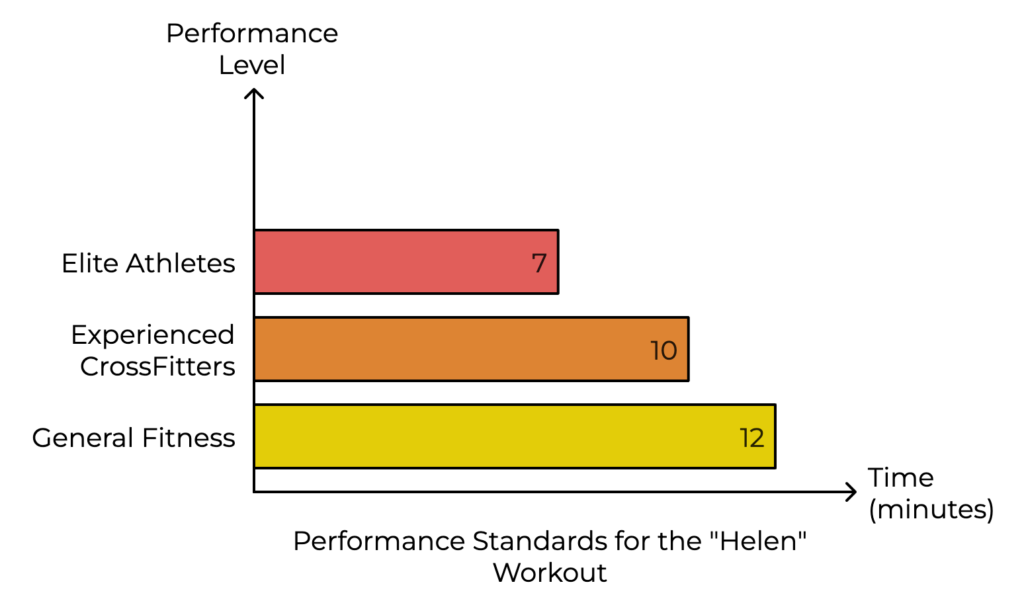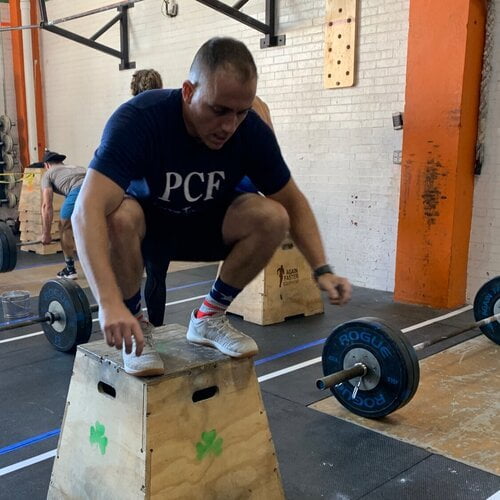The Ultimate Guide To The Helen CrossFit Workout
If you’re looking for a CrossFit workout that tests your cardiovascular endurance, strength, and stamina all at once, then Helen is the one to try.
Helen is one of CrossFit’s most iconic benchmark workouts, designed to push you both physically and mentally.
As a Doctor of Physical Therapy and a remote CrossFit coach, I have spent years helping athletes enhance their fitness and prevent injury through benchmark workouts like Helen, making me uniquely qualified to guide you through the workout’s structure, benefits, and strategies for success.
Whether you’re a seasoned CrossFit athlete or just getting started, this workout offers a full-body challenge that reveals your fitness progress over time.
In this blog, you’ll get a complete breakdown of the Helen workout—its structure, significance, benefits, and tips on how to tackle it so that you can post your best time to date.
What Is The Helen CrossFit Workout?
Helen is a fast-paced CrossFit workout designed to test your overall fitness.
It’s simple yet highly effective, making it a go-to benchmark in the CrossFit world. (1)
You’ll complete 3 rounds for time, meaning the goal is to finish as quickly as possible while maintaining good form.
By the end, you’re left with a well-rounded test of your endurance, strength, and stamina.
The Helen WOD:
3 Rounds For Time
400 m run
21 kettlebell swings 53/35#
12 pull ups
The History and Significance of Helen
Helen is one of the original “Girl” CrossFit workouts, a group of benchmark WODs designed to challenge you and track your fitness progress.
First introduced on the CrossFit main site in August 2003, Helen quickly became a staple in the CrossFit community.
The “Girl” workouts, like Helen, are iconic because they offer a standardized way to measure improvement over time.
By revisiting Helen periodically, you can assess how much faster, stronger, or more efficient you’ve become, making it a true test of your fitness journey.
Breaking Down the Exercises in Helen
1. 400-Meter Run
The 400-meter run is the cardio portion of Helen that challenges your cardiovascular endurance.
This run kicks off each round, setting the pace for the rest of the workout.
Your goal here is to maintain a steady speed without burning out too early.
Pacing yourself is key, as this run plays a significant role in keeping your intensity up across all three rounds.
2. Kettlebell Swings (21 Reps)
Kettlebell swings (American kettlebell swings) target your posterior chain muscles, specifically your glutes, hamstrings, and lower back.
For men, the prescribed weight is 53 lbs (24 kg), and for women, it’s 35 lbs (16 kg).
The movement demands a combination of strength and endurance, so focusing on proper form is crucial.
Make sure you’re driving the swing with your hips and keeping your back neutral for both efficiency and safety during the workout.
3. Pull-ups (12 Reps)
Pull-ups are the final test of each round, focusing on upper body strength and grip endurance.
If you’re unable to do pull-ups just yet, don’t worry—there are scaling options available.
You can substitute with ring rows or banded pull-ups to ensure you’re still getting the same benefits while building up your strength for unassisted pull-ups in the future.
Strategy for Helen: How to Approach the Workout
When tackling Helen, pacing is everything.
You’ll want to maintain an efficient pace across all three rounds, keeping your energy levels and heart rate steady for each movement.
Experienced athletes often aim to perform unbroken pull-ups and kettlebell swings, which means going straight through the reps without stopping.
If you’re up for the challenge, focus on conserving energy during the run so you have enough in the tank to tackle these movements at full capacity with no or short breaks.
If you have the appropriate skill level, I would suggest utilizing butterfly pull-ups to optimize your efficiency on the pull-up bar.
Pacing your run is key—go fast, but not so fast that you’re drained before hitting the kettlebell swings and pull-ups.
The goal is consistency, allowing you to maintain intensity without crashing before the final round.
Scaling Options for Helen
If you’re not ready to tackle Helen as prescribed, don’t worry—there are plenty of scaling options that can still give you a great workout.
You can shorten the run distance to 200 or 300 meters if the full 400 meters feels too taxing.
For the kettlebell swings, using a lighter weight is another great way to scale while keeping the movement functional.
Finally, if pull-ups are a struggle, modify them by performing ring rows or using bands for assistance.
Remember, scaling the workout doesn’t take away from the challenge—it simply adjusts it to match your current fitness level while keeping the core stimulus of Helen intact.
If you are an athlete with a higher ability level then you may opt for chest-to-bar pull-ups and a heavier kettlebell.
But, it is a good idea to refrain from this until your times approach elite status.
Performance Standards and Elite Times
When it comes to Helen, elite athletes set the bar high, with top-tier performers finishing the workout in under 7 minutes. (3)
For experienced CrossFitters, a sub-10-minute time is considered a strong performance.
These time markers serve as excellent benchmarks for tracking your fitness progress.
By testing yourself against these standards, you can gauge improvements in your cardiovascular endurance, strength, and stamina over time.
As you improve your technique and efficiency with each exercise, you’ll notice your Helen time getting faster, serving as proof of your overall fitness progression.

Benefits of the Helen Workout
Helen offers an intense, full-body workout that challenges multiple aspects of fitness.
With the 400-meter run, you’ll boost your cardiovascular endurance, while the kettlebell swings and pull-ups focus on building muscular strength and stamina.
It’s a perfect blend of conditioning and strength work.
Beyond the physical challenge, Helen pushes you mentally.
As fatigue sets in, especially during the later rounds, you’ll need mental grit to maintain your pace and push through to finish as quickly as possible.
Studies on high-intensity functional training, like CrossFit, highlight significant improvements in aerobic capacity, muscular endurance, and body composition. (2)
These benefits are precisely what you gain from tackling a workout like Helen, making it a powerful tool for overall fitness development.
Common Mistakes and How to Avoid Them
To get the most out of Helen, it’s important to avoid some common mistakes that can undermine your performance and lead to injury.
Incorrect Pacing
One of the biggest errors is going out too fast on the run.
While you might feel fresh in the first round, overexerting yourself early on will cause fatigue during the kettlebell swings and pull-ups, slowing you down in the later rounds.
Focus on maintaining a steady pace to preserve energy for the entire workout.
Poor Form on Kettlebell Swings
A common mistake with kettlebell swings is failing to maintain a proper hip hinge, which can put unnecessary strain on your lower back.
Ensure that you’re engaging your glutes and hamstrings to drive the kettlebell up, and keep your back flat to avoid injury.
Losing the Hollow Body Position During Pull-ups
Maintaining a tight hollow body position is crucial for efficient pull-ups.
If you lose this position, you’ll struggle to transfer power through your kip, leading to inefficient repetitions and faster fatigue.
Focus on keeping your core tight and your movement controlled for smooth, powerful pull-ups.
Wrapping Up on The Helen CrossFit Workout
Helen is a classic CrossFit workout in CrossFit for good reason.
It challenges your cardiovascular endurance, strength, and mental toughness all in a single, fast-paced workout.
Whether you’re one of the few CrossFit Games athletes or just starting, Helen offers an excellent test of your fitness and an opportunity to track your progress over time.
Don’t hesitate to give it a try—just be sure to scale the workout as needed, prioritize your technique, and maintain the stimulus for long-term success in your training.
Now it’s time to hit the gym, tackle Helen, and see how far you can push yourself!
If you found this post helpful, consider subscribing to the free Bulletproof Training Program Newsletter to elevate your athletic performance entirely for free.
As a newsletter subscriber, you’ll get free weekly training that can be done in your garage or in your CrossFit gym, as well as deep dives on training concepts like this, designed to help you train smarter and reach your goals faster.
Helen CrossFit Workout FAQ
1. How long does it take to complete the Helen workout?
Most experienced CrossFit athletes aim to complete Helen in under 10 minutes, with elite-level athletes often finishing in less than 7 minutes.
Your time will vary depending on your fitness level, pacing, and ability to perform the exercises unbroken.
2. Can beginners do the Helen workout?
Yes, beginners can perform Helen by scaling the workout to fit their current fitness level.
This might include shortening the run distance, using a lighter kettlebell, or modifying pull-ups with ring rows or band assistance.
3. How often should I do Helen to track my progress?
You can retest Helen every few months as part of your training routine. Benchmark workouts like Helen help measure improvements in endurance, strength, and overall fitness over time.
References:
1. CrossFit. (2021, July 26). Workout of the day 210726. CrossFit. https://www.crossfit.com/210726
2. Menargues-Ramírez, R., Sospedra, I., Holway, F., Hurtado-Sánchez, J. A., & Martínez-Sanz, J. M. (2022). Evaluation of Body Composition in CrossFit® Athletes and the Relation with Their Results in Official Training. International journal of environmental research and public health, 19(17), 11003. https://doi.org/10.3390/ijerph191711003
3. CrossFit. (2023). Athletes tackle Helen at CrossFit Games. CrossFit. https://www.crossfit.com/essentials/athletes-tackle-helen-at-crossfit-games







